ARM9-based SoC targets low-end PMPs
Apr 23, 2008 — by LinuxDevices Staff — from the LinuxDevices Archive — 20 views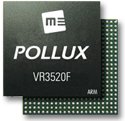 Korean chipmaker MagicEyes Digital has announced an ARM9-based system-on-chip (SoC) intended for low-end navigation devices and PMPs (personal media players). The Linux-friendly “Pollux” SoC features on-chip 3D graphics acceleration, an NTSC/PAL video encoder, and a video DAC with picture-in-picture capabilities.
Korean chipmaker MagicEyes Digital has announced an ARM9-based system-on-chip (SoC) intended for low-end navigation devices and PMPs (personal media players). The Linux-friendly “Pollux” SoC features on-chip 3D graphics acceleration, an NTSC/PAL video encoder, and a video DAC with picture-in-picture capabilities.
The Pollux is produced using a 90nm process and comes in a 288-pin, 15mm x 15mm FBGA (fine pitch ball grid array) package. A 533MHz ARM926EJ core includes 16Kb caches for both instructions and data, and incorporates ARM's Jazelle Java hardware accelerator.
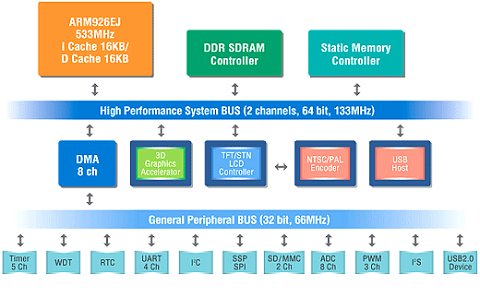
A block diagram of the MagicEyes Pollux
Said to be suitable for applications such as 3D mapping, the Pollux's 3D graphics accelerator supports one digital and one analog display simultaneously, with screen sizes up to 1280 x 1024 pixels. Open GL ES 1.1-compliant, the accelerator can do 3D texture mapping, lighting, shading, fogging, Z-Buffering, and alpha-blending. It can manipulate 133M texels (texture elements) or 1.33M polygons per second, MagicEyes claims.
Other features and specifications listed by MagicEyes for the Pollux include:
- DDR SDRAM controller
- 133MHz DDR SDRAM memory x 16bit
- Single DDR memory bank
- Supports up to 128MB, peak memory bandwidth 533MB/sec
- 133MHz DDR SDRAM memory x 16bit
- Static bus controller
- 16-bit data bus
- Supports 8-bit NAND flash and 8/16-bit SRAM
- Supports SLC/MLC NAND flash
- Boots from NAND flash or NOR flash
- IDE interface with PIO mode
- 16-bit data bus
- Integrated peripherals:
- USB 2.0 host/device
- I2C
- 4 x serial
- SSP/SPI
- 2-channel SD/MMC
- I2S
- USB 2.0 host/device
- Power management modes:
- Individual block dynamic power controller
- Supports various power-down modes (idle/stop)
- Individual block dynamic power controller
- Operating temperature — 0 to 70 deg. C
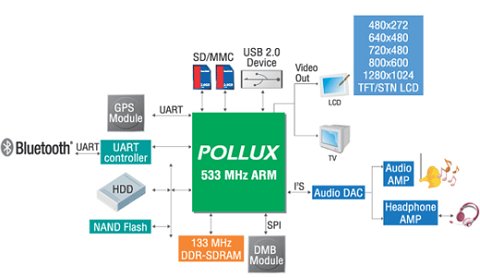
The Pollux envisioned as part of a complete device
As shown in the illustration above, MagicEyes envisions the Pollux becoming the heart of a complete PND (personal navigation device) or PMP (personal media player). It would be connected to a GPS module serially, to an audio DAC via I2S, and to a television receiver via SPI.
Development kit
The Pollux has already been used in a hardware development kit, made available by fellow Korean vendor Aiji System. However, the kit appears to be available only with Windows CE 5.0 and 6.0 BSPs (board support packages), initially.
Shown below, the “Pollux DTK” offers a 4.3-inch touchscreen LCD display with 480 x 272 pixel resolution, five navigation keys, 128MB of RAM, and 76MB of flash. Offering PC-style interfaces including dual serial ports and a 10/100 Ethernet connector, it also adds an audio DAC and provides composite video output.
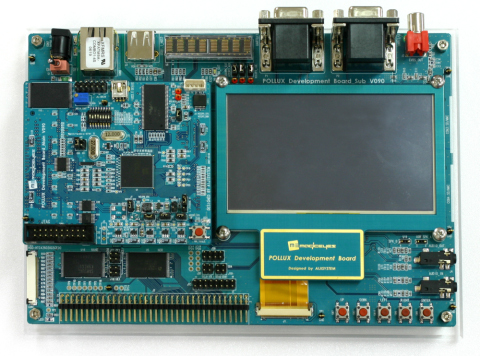
The Pollux DTK development board
(Click to enlarge)
Features and specifications listed by Aiji System for the Pollux DTK include:
- Processor — MagicEyes Pollux, with ARM926EJ core clocked at 533MHz
- Memory:
- 128MB of DDR DRAM
- 64MB SLC NAND flash
- 8MB MLC NAND flash
- 4MB NOR flash
- 128MB of DDR DRAM
- Display — 4.3-inch touchscreeen display with 480 x 272 resolution
- Keys — 5 navigation buttons and power switch
- Networking — 10/100 Ethernet
- Other I/O:
- USB 1.1 host
- USB 2.0 device
- 4 x RS232 (2 with PC-style connectors)
- composite video output
- audio line in and line out
- USB 1.1 host
- Expansion — SD interface
- Power supply — 5VDC
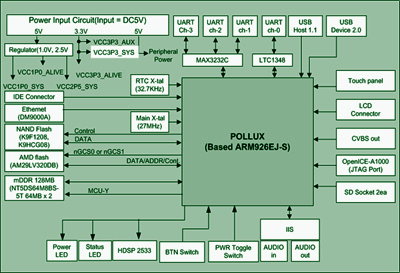
A block diagram of the Pollux development board
In addition to supporting Linux, the MagicEyes Pollux SoC runs Windows CE 5.0 and 6.0. Pricing or availability information was not provided by MagicEyes, but the chip appears to be available now. The Pollux DTK comes with Windows CE 5.0 and a Windows CE board support package (BSP). For more information, see the Aiji System website, here.
This article was originally published on LinuxDevices.com and has been donated to the open source community by QuinStreet Inc. Please visit LinuxToday.com for up-to-date news and articles about Linux and open source.